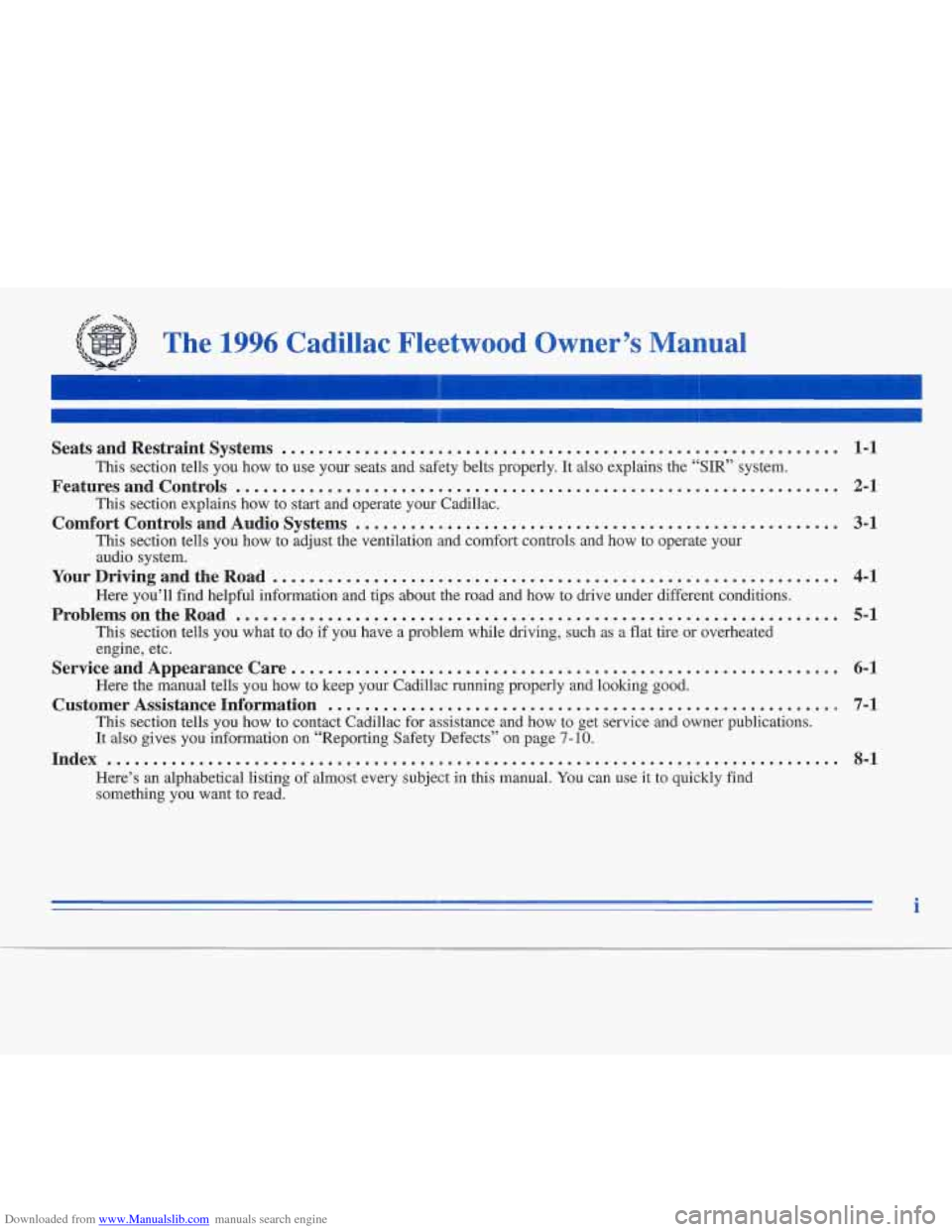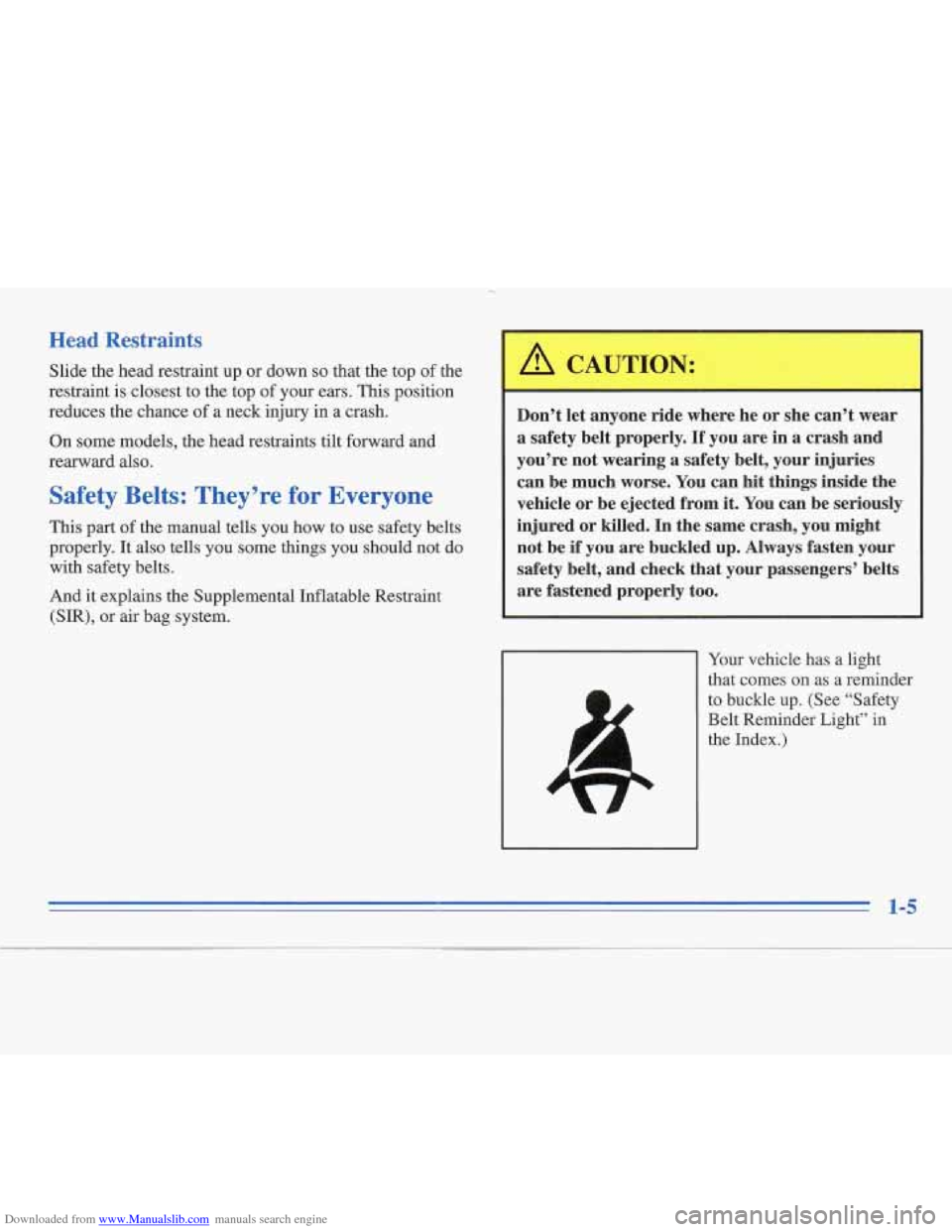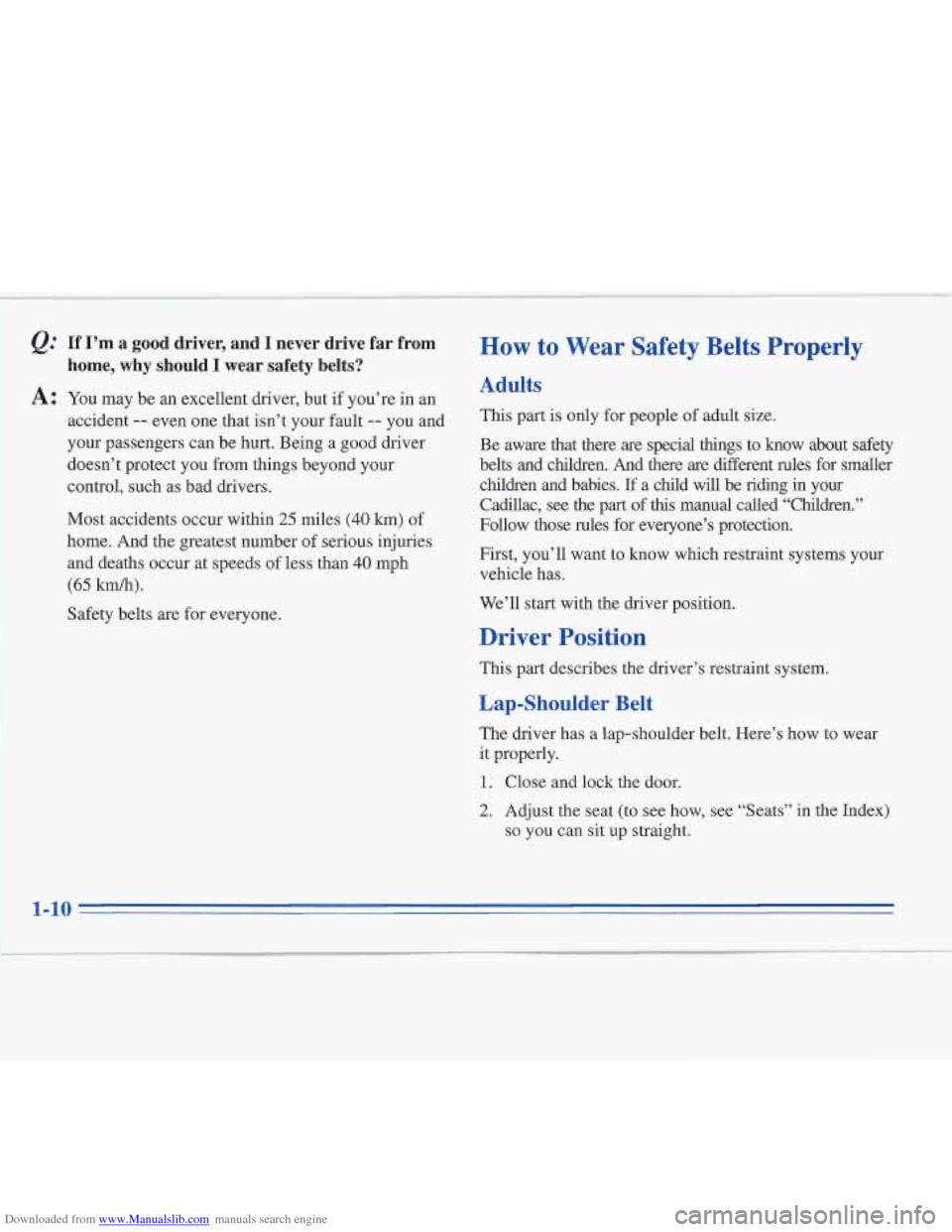Page 2 of 306

Downloaded from www.Manualslib.com manuals search engine /F -as
The 1996 Cadillac Fleetwood Owner’s Manual
Seats and Restraint Systems ............................................................. 1-1
Features and Controls .................................................................. 2-1
Comfort Controls and Audio Systems ..................................................... 3-1
This section tells you how to use your seats and safety belts properly. It also explains the “SIR” system.
This section explains how to start and operate your Cadillac.
This section tells you how to adjust the ventilation and comfort controls and how to operate your
audio system.
Here you’ll find helpful information and tips about the road and how to drive under different conditions.
This section tells you what to do if you have a problem while driving, such as a flat tire or overheated
engine, etc.
Here the manual tells you how to keep your Cadillac running properly and looking
good.
This section tells you how to contact Cadillac for assistance and how to get service and owner publications.
It also gives you information on “Reporting Safety Defects” on page 7-10.
YourDrivingandtheRoad .............................................................. 4-1
ProblemsontheRoad .................................................................. 5-1
ServiceandAppearanceCare ............................................................ 6-1
Customer Assistance Information ........................................................ 7-1
Index ........................................................................\
........ 8-1
Here’s an alphabetical listing of almost every subject in this manual. You can use it to quickly find
something you want to read.
i
Page 14 of 306
Downloaded from www.Manualslib.com manuals search engine Vehicle Symbols
These are some of the symbols you will find on your vehicle.
For example,
these symbols
are used on an
original battery:
POSSIBLE A
CAUTION
INJURY
PROTECT EYES BY
SHIELDING
CAUSTIC
ACID COULD
&
BAllERY
CAUSE
BURNS
AVOID
SPARKS
OR
FLAMES
SPARK
OR ,\I/,
COULD FLAME
EXPLODE BATTERY
These symbols are important
for you and
your passengers
whenever your
vehicle
is
driven:
DOOR LOCK
UNLOCK
FASTEN SEAT
BELTS
POWER
WINDOW
These symbols
have to do with
your lights:
SIGNALS e
TURN
PAERK pf
FOG LAMPS $0
These symbols
are on some
of
your controls:
WIPER w
WINDSHIELD
DEFROSTER
WINDOW
DEFOGGER
VENTILATING FAN
These symbols are used
on
warning and
indicator lights:
COOLANT
TEMP
-
CHARGING Tql
BAllERY
SYSTEM
BRAKE
(0)
COOLANT a
ENGINE OIL e,
PRESSURE
ANTI-LOCK
(a)
BRAKES
Here are some
other symbols
you may see:
FUSE -%-
t
LIGHTER m
HORN )cr
SPEAKER
b
FUEL e3
xiii
Page 16 of 306
Downloaded from www.Manualslib.com manuals search engine ,.Le --y
Section 1 Seats and Restraint Systems
Here you’ll find information about the seats in your
Cadillac and how to use your safety belts properly.
You
can also learn about some things you should not do with
air bags and safety belts.
Seats and Seat Controls
This section tells you about the seats -- how to adjust
them, and also about reclining front seatbacks and
head restraints.
Power Seat Controls
The controls are located on both front door armrests.
0 The front TILT control makes the front portion of the
seat cushion move up or down.
1-1
Page 19 of 306
Downloaded from www.Manualslib.com manuals search engine But don’t have a seatback reclined if your vehicle is moving.
I)
Sitting in a reclined position when your vehicle is
in motion can be dangerous. Even if you buckle
up, your safety belts can’t do their job when
you’re reclined like this.
The shoulder belt can’t do
its job because it
won’t be against your body. Instead, it will be in
front of you. In a crash you could go into it,
receiving neck or other injuries.
The lap belt can’t do, its job either. In
a crash the
belt could go up over your abdomen. The belt
forces would be there, not
at your pelvic bones.
This could cause serious internal injuries. ’
For proper protection when the vehicle is in
motion, have the seatback upright. Then sit
well back in the seat and wear your safety
belt properly.
Page 20 of 306

Downloaded from www.Manualslib.com manuals search engine Head Restraints
Slide the head restraint up or down so that the top of the
restraint is closest to the top
of your ears. This position
reduces the chance of
a neck injury in a crash.
On some models, the head restraints tilt forward and
rearward also.
Safety Belts: They’re for Everyone
This part of the manual tells you how to use safety belts
properly. It also tells you some things you should not do
with safety belts.
And it explains the Supplemental Inflatable Restraint
(SIR), or air bag system.
Don’t let anyone ride where he or she can’t wear
a safety belt properly.
If you are in a crash and
you’re not wearing
a safety belt, your injuries
can be much worse. You can hit things inside the
vehicle or be ejected from it. You can be seriously
injured or killed. In the same crash, you might
not be
if you are buckled up. Always fasten your
safety belt, and check that your passengers’ belts
are fastened properly too.
Your vehicle has a light
that comes on as a reminder
to buckle up. (See “Safety
Belt Reminder Light” in the Index.)
Page 21 of 306
Downloaded from www.Manualslib.com manuals search engine In most states and Canadian provinces, the law says to
wear safety belts. Here’s why: They work.
You never know if you’ll be in a crash. If you do have a
crash, you don’t
know if it will be a bad one.
A few crashes are mild, and some crashes can be so
serious that even buckled up a person wouldn’t survive.
But most crashes are in between. In many of them,
people who buckle up can survive and sometimes
walk away. Without belts they could have been badly
hurt or killed.
Why Safety Belts Work
When you ride in or on anything, you go as fast as it goes.
After more than
25 years of safety belts in vehcles,
the facts
are clear. In most crashes buckling up does
matter
... a lot!
Take the simplest vehicle. Suppose
it’s just a seat
on wheels.
1-6
Page 25 of 306

Downloaded from www.Manualslib.com manuals search engine @ If I’m a good driver, and I never drive far from
A: You may be an excellent driver, but if you’re in an
home, why should I wear safety belts?
accident -- even one that isn’t your fault -- you and
your passengers can be hurt. Being a good driver
doesn’t protect
you from things beyond your
control, such as bad drivers.
Most accidents occur within
25 miles (40 km) of
home. And the greatest number of serious injuries
and deaths occur at speeds
of less than 40 mph
(65 kmh).
Safety belts are for everyone.
How to Wear Safety Belts Properly
Adults
This part is only for people of adult size.
Be aware that there are special things to know about safety
belts and children. And there
are different rules for smaller
children and babies.
If a child will be riding in your
Cadillac, see the
part of this manual called “Children.”
Follow those rules for everyone’s protection.
First, you’ll want to know which restraint systems your
vehicle has.
We’ll start with the driver position.
Driver Position
This part describes the driver’s restraint system.
Lap-Shoulder Belt
The driver has a lap-shoulder belt. Here’s how to wear
it properly.
1. Close and lock the door.
2. Adjust the seat (to see how, see “Seats” in the Index)
so you can sit up straight.
1-10
Page 27 of 306
Downloaded from www.Manualslib.com manuals search engine Shoulder Belt Tightness Adjustment
Your car has a shoulder belt tightness adjustment
feature. If the shoulder belt seems too tight, adjust it
before you begin to drive.
1. Sit well back in the seat.
2. Start pulling the shoulder belt out.
4. Let the belt go back all the way. You should hear a
slight clickmg sound. If you don’t, the adjustment
feature won’t set, and you’ll have to start again.
3. Just before it reaches the end, give it a quick pull.
5. Now you can add a small mount of slack. Lean
forward slightly, then sit back.
If you’ve added more
than
1 inch (25 mm) of slack, pull the shoulder belt
out as you did before and start again.
If
you move around in the vehicle enough, or if you pull
out the shoulder belt, the belt will become tight again.
If
this happens, you can reset it.
t
1-12